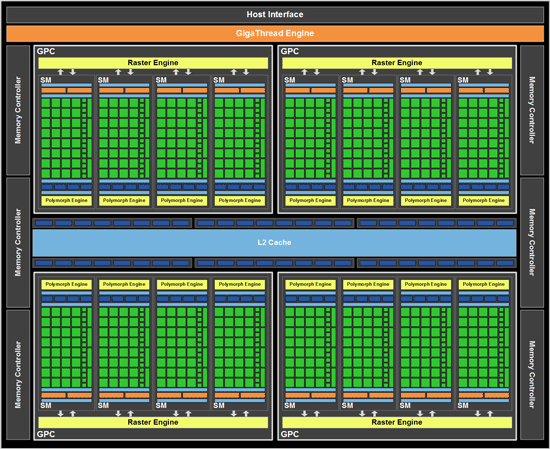NVIDIA's GeForce GTX 580: Fermi Refined
by Ryan Smith on November 9, 2010 9:00 AM ESTGF110: Fermi Learns Some New Tricks
We’ll start our in-depth look at the GTX 580 with a look at GF110, the new GPU at the heart of the card.
There have been rumors about GF110 for some time now, and while they ultimately weren’t very clear it was obvious NVIDIA would have to follow up GF100 with something else similar to it on 40nm to carry them through the rest of the processes’ lifecycle. So for some time now we’ve been speculating on what we might see with GF100’s follow-up part – an outright bigger chip was unlikely given GF100’s already large die size, but NVIDIA has a number of tricks they can use to optimize things.
Many of those tricks we’ve already seen in GF104, and had you asked us a month ago what we thought GF110 would be, we were expecting some kind of fusion of GF104 and GF100. Primarily our bet was on the 48 CUDA Core SM making its way over to a high-end part, bringing with it GF104’s higher theoretical performance and enhancements such as superscalar execution and additional special function and texture units for each SM. What we got wasn’t quite what we were imagining – GF110 is much more heavily rooted in GF100 than GF104, but that doesn’t mean NVIDIA hasn’t learned a trick or two.
Fundamentally GF110 is the same architecture as GF100, especially when it comes to compute. 512 CUDA Cores are divided up among 4 GPCs, and in turn each GPC contains 1 raster engine and 4 SMs. At the SM level each SM contains 32 CUDA cores, 16 load/store units, 4 special function units, 4 texture units, 2 warp schedulers with 1 dispatch unit each, 1 Polymorph unit (containing NVIDIA’s tessellator) and then the 48KB+16KB L1 cache, registers, and other glue that brought an SM together. At this level NVIDIA relies on TLP to keep a GF110 SM occupied with work. Attached to this are the ROPs and L2 cache, with 768KB of L2 cache serving as the guardian between the SMs and the 6 64bit memory controllers. Ultimately GF110’s compute performance per clock remains unchanged from GF100 – at least if we had a GF100 part with all of its SMs enabled.
On the graphics side however, NVIDIA has been hard at work. They did not port over GF104’s shader design, but they did port over GF104’s texture hardware. Previously with GF100, each unit could compute 1 texture address and fetch 4 32bit/INT8 texture samples per clock, 2 64bit/FP16 texture samples per clock, or 1 128bit/FP32 texture sample per clock. GF104’s texture units improved this to 4 samples/clock for 32bit and 64bit, and it’s these texture units that have been brought over for GF110. GF110 can now do 64bit/FP16 filtering at full speed versus half-speed on GF100, and this is the first of the two major steps NVIDIA took to increase GF110’s performance over GF100’s performance on a clock-for-clock basis.
| NVIDIA Texture Filtering Speed (Per Texture Unit) | |||||
| GF110 | GF104 | GF100 | |||
| 32bit (INT8) | 4 Texels/Clock | 4 Texels/Clock | 4 Texels/Clock | ||
| 64bit (FP16) | 4 Texels/Clock | 4 Texels/Clock | 2 Texels/Clock | ||
| 128bit (FP32) | 1 Texel/Clock | 1 Texel/Clock | 1 Texel/Clock | ||
Like most optimizations, the impact of this one is going to be felt more on newer games than older games. Games that make heavy use of 64bit/FP16 texturing stand to gain the most, while older games that rarely (if at all) used 64bit texturing will gain the least. Also note that while 64bit/FP16 texturing has been sped up, 64bit/FP16 rendering has not – the ROPs still need 2 cycles to digest 64bit/FP16 pixels, and 4 cycles to digest 128bit/FP32 pixels.
It’s also worth noting that this means that NVIDIA’s texture:compute ratio schism remains. Compared to GF100, GF104 doubled up on texture units while only increasing the shader count by 50%; the final result was that per SM 32 texels were processed to 96 instructions computed (seeing as how the shader clock is 2x the base clock), giving us 1:3 ratio. GF100 and GF110 on the other hand retain the 1:4 (16:64) ratio. Ultimately at equal clocks GF104 and GF110 widely differ in shading, but with 64 texture units total in both designs, both have equal texturing performance.
Moving on, GF110’s second trick is brand-new to GF110, and it goes hand-in-hand with NVIDIA’s focus on tessellation: improved Z-culling. As a quick refresher, Z-culling is a method of improving GPU performance by throwing out pixels that will never be seen early in the rendering process. By comparing the depth and transparency of a new pixel to existing pixels in the Z-buffer, it’s possible to determine whether that pixel will be seen or not; pixels that fall behind other opaque objects are discarded rather than rendered any further, saving on compute and memory resources. GPUs have had this feature for ages, and after a spurt of development early last decade under branded names such as HyperZ (AMD) and Lightspeed Memory Architecture (NVIDIA), Z-culling hasn’t been promoted in great detail since then.

Z-Culling In Action: Not Rendering What You Can't See
For GF110 this is changing somewhat as Z-culling is once again being brought back to the surface, although not with the zeal of past efforts. NVIDIA has improved the efficiency of the Z-cull units in their raster engine, allowing them to retire additional pixels that were not caught in the previous iteration of their Z-cull unit. Without getting too deep into details, internal rasterizing and Z-culling take place in groups of pixels called tiles; we don’t believe NVIDIA has reduced the size of their tiles (which Beyond3D estimates at 4x2); instead we believe NVIDIA has done something to better reject individual pixels within a tile. NVIDIA hasn’t come forth with too many details beyond the fact that their new Z-cull unit supports “finer resolution occluder tracking”, so this will have to remain a mystery for another day.
In any case, the importance of this improvement is that it’s particularly weighted towards small triangles, which are fairly rare in traditional rendering setups but can be extremely common with heavily tessellated images. Or in other words, improving their Z-cull unit primarily serves to improve their tessellation performance by allowing NVIDIA to better reject pixels on small triangles. This should offer some benefit even in games with fewer, larger triangles, but as framed by NVIDIA the benefit is likely less pronounced.
In the end these are probably the most aggressive changes NVIDIA could make in such a short period of time. Considering the GF110 project really only kicked off in earnest in February, NVIDIA only had around half a year to tinker with the design before it had to be taped out. As GPUs get larger and more complex, the amount of tweaking that can get done inside such a short window is going to continue to shrink – and this is a far cry from the days where we used to get major GPU refreshes inside of a year.











160 Comments
View All Comments
knutjb - Tuesday, November 9, 2010 - link
I agree guys it should be a 485 not a 580.The 6870 is a sore spot on an otherwise solid refinement. Curious to see its SLI performance. $559 on Newegg this am.
dtham - Tuesday, November 9, 2010 - link
Anyone know if aftermarket cooling for the GTX 480 will work for the GTX 580? It would be great to be able to reuse a waterblock from a GTX 480 for the new 580s. Looking at the picture the layout looks similar.mac2j - Tuesday, November 9, 2010 - link
In Europe the GTX 580 was launched at 399 Euros and in response ATI has lowered the 5970 to 389 Euros (if you believe the rumors).This can only bode well for holiday prices of the 6970 vs 580.
samspqr - Tuesday, November 9, 2010 - link
it's already listed and in stock at alternate.de, but the cheapest one is 480eurthe only 5970 still in stock there is 540eur
yzkbug - Tuesday, November 9, 2010 - link
I moved all my gaming to the living room on a big screen TV and HTPC (a next next gen console in a sense). But, Optimus would be the only way to use this card on HTPC.slatr - Tuesday, November 9, 2010 - link
Ryan,Would you be able to test with Octane Renderer?
I am interested to see if Octane gets throttled.
Thanks
Andyburgos - Tuesday, November 9, 2010 - link
Ryan:I hold you in the most absolute respect. Actually, in my first post a while ago I praised your work, and I think you´re quite didactic and fun to read. On that, thanks for the review.
However, I need to ask you: W.T.F. is wrong with you? Aren´t you pissed off by the fact that GTX480 was a half baked chip (wouldn´t say the same about GTX460) and now that we get the real version they decided to call it 580? Why isn´t a single complain about that in the article?
If, as I understand, you think that the new power / temperature / noise / performance balance has improved dramatically from the 480, I think you are smart enough to see that it was because the 480 was very, very, unpolished chip. This renaming takes us for stupid, is even worse than what AMD did.
/rant
AT & staff, I think you have a duty to tell off lousy tactics such as the Barts being renamed 68x0, or the 8800 becoming 9800 then GTS250 as you always did. You have failed so badly to do that here that you look really biased. For me, a loyal argentinian reader since 2001, that is absolutely imposible, but with the GXT460 and this you are acomplishing that.
+1 for this card deserving an indifferent thumbs up, as Ryan graciously said, not for the card itself (wich is great) but for the nVidia tactics and the half baked 480 they gave us. Remember the FX5800 (as bad or worse than the 480) becoming the 5900... gosh, I think those days are over. Maybe that´s why I stick with my 7300 GT, haha.
I respectfully disent with your opinion, but thanks for the great review.
Best regards,
Andy
ViRGE - Tuesday, November 9, 2010 - link
Huh, are we reading the same article? See page 4.chizow - Tuesday, November 9, 2010 - link
I'd have to agree he probably didn't read the article thoroughly, beside explicitly saying this is the 2nd worst excuse for a new naming denomination, Ryan takes jabs at the 480 throughout by repeatedly hinting the 580 is what Fermi should've been to begin with.Sounds like just another short-sighted rant about renaming that conveniently forgets all the renaming ATI has done in the past. See how many times ATI renamed their R200 and R300 designs, even R600 and RV670 fall into the same exact vein as the G92 renaming he bemoans......
Haydyn323 - Tuesday, November 9, 2010 - link
Nvidia has done no different than ATI has as far as naming in their new cards. They simply jumped on the naming bandwagon for marketing and competetive purposes since ATI had already done so.... at least the 580 is actually faster than the 480. ATI releasing a 6870 that is far inferior to a 5870 is worse in my mind.It should indeed have been a 485, but since ATI calls their new card a 6870 when it really should be a 5860 or something, it only seems fair.